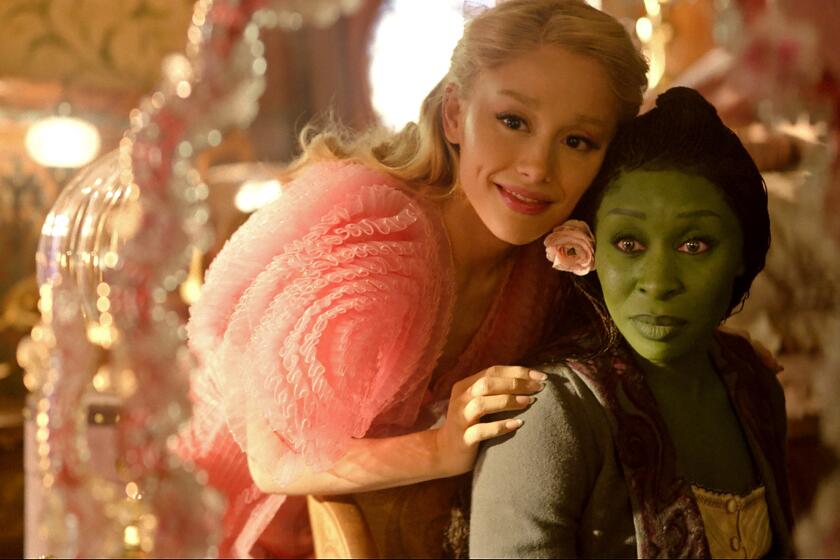Academy Museum moves to production with City Council’s green light
The film capital of the world is finally getting a museum to showcase cinema history.
On a 13-0 vote, the Los Angeles City Council on Wednesday gave final approval for a $300-million museum to be built on the former May Co. department store site on Wilshire Boulevard at Fairfax Avenue, adjoining the Los Angeles County Museum of Art.
------------
FOR THE RECORD: In the June 25 Calendar section, an article about the Los Angeles City Council approving the Academy Museum of Motion Pictures said that the Academy of Motion Picture Arts and Sciences had sponsored a failed attempt in the 1960s to establish a film museum in Los Angeles. Hollywood Museum Associates, a nonprofit group, was in charge of the 1960s project.
------------
Scheduled to open in 2017, the 290,000-square-foot Academy Museum of Motion Pictures will feature a treasure trove of Hollywood memorabilia and a 1,000-seat domed theater for screenings and events.
Designed by Italian architect Renzo Piano, the project is being built by the Academy of Motion Picture Arts and Sciences with contributions from an array of film industry heavyweights, including Steven Spielberg, Jeffrey Katzenberg, David Geffen, Dolby Laboratories and China’s Dalian Wanda Group.
“I grew up here in Southern California and always said, ‘Why is there not a film museum in the heart of filmmaking territory?’” said Kerry Brougher, the film museum’s director. “Finally, after today, we will be able to achieve that.”
Construction is expected to begin this summer, but one potential hurdle remains. Fix the City, a nonprofit activist organization, has said it is weighing legal action to stall development. The group contends the project was ramrodded through the City Council without enough time to assess potential problems, including increased traffic and inadequate parking for the estimated 860,000 people expected to visit the museum annually.
“I’ve got my war paint on now,” said James O’Sullivan, vice president of Fix the City and head of the Miracle Mile Residential Assn. “If it were up to me I would say, ‘Bring on the attorneys.’”
Academy executives said there is sufficient parking because in addition to using LACMA’s parking lots they are leasing 800 spaces nearby to use when the LACMA lots fill up. Museum leaders say the overflow parking will prevent snarls.
One thing that apparently isn’t a problem: money. Bill Kramer, managing director of the Academy Museum, said it has received $250 million in cash and pledges. The academy isn’t seeking public funding, apart from applying for relatively small grants for specific projects.
The academy long has dreamed of establishing the world’s grandest film museum. Its stumbled in the early 1960s after the Los Angeles County Board of Supervisors gifted it land in Hollywood and $1.3 million, plus a green light for construction. Ground was broken, but internal dissension over funding and how the museum should interpret and display film history sank the project.
For the new museum, Piano’s design calls for constructing a 130-foot-high dome north of the 1939-vintage May Co. building, whose interior will be reconfigured. Two floors will be devoted to permanent exhibits that take visitors through cinematic history starting with the first moving images; the top floor will have temporary exhibitions.
The academy will import some touring exhibitions from other museums, but it aims to tap its large collection of documents, photographs and artifacts such as props, costumes, movie cameras and other technical equipment to launch major shows in L.A., then export them to museums around the world.
The ground floor has another large gallery whose theme Brougher said is still being developed. A second cinema of about 275 seats will occupy a below-ground level. The big domed one will topped by a glassed-in view deck offering panoramic vistas in all directions.
The museum will charge an as-yet to be determined admission fee, except for a display in its lobby, which will be open to the public for free.
Brougher said he’s in the process of hiring a staff for exhibitions and programs that will total 60 to 70 employees, including four or five curators who’ll research the collection, brainstorm ideas for exhibitions and see them through to fruition.
Besides focusing on particular films, filmmakers and actors, Brougher said, the museum’s exhibitions may well tackle broader themes. For example, he said, “we might deal with the nature of celebrity, the whole dream machine that helps create” the world of cinema.
The council’s OK on Wednesday sparked an instant celebration among museum backers. Dawn Hudson, the motion picture academy’s chief executive, cried as soon as the council voted.
She said afterward that she hadn’t expected to tear up, but it had hit her emotionally because “this day is an event we’ve been waiting for and working toward for a long time.”
After hugs all around inside the council chamber, Tom LaBonge, the outgoing City Council member whose district includes the museum site, ushered more than 30 academy officials and other supporters onto the City Hall steps for group pictures and further celebration.
Soon, Mayor Eric Garcetti came out to add his congratulations.
“Enjoy this moment. Enjoy your victory,” the mayor told Hudson, academy President Cheryl Boone Isaacs and key museum staffers.
Then someone mentioned the neighbors’ objections and potential lawsuit. “Welcome to my world,” Garcetti quipped.
More to Read
The biggest entertainment stories
Get our big stories about Hollywood, film, television, music, arts, culture and more right in your inbox as soon as they publish.
You may occasionally receive promotional content from the Los Angeles Times.











